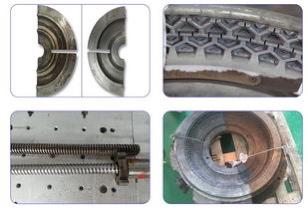Precision laser cleaning machine is a safer, chemical free, repeatable cleaner for rust removal, paint stripping, coating removal, oil ablation for surface treatment in industrial cleaning with mold, precision instrument, aviation, ship, weaponry, building exterior, electronics, and nuclear power plant.
High-end manufacturing and energy conservation and emission reduction have an increasingly urgent need for advanced processes. In terms of industrial surface treatment, there is an urgent need for a comprehensive upgrade of technology and processes. Traditional industrial cleaning processes, such as mechanical friction cleaning, chemical corrosion cleaning, strong impact cleaning, high-frequency ultrasonic cleaning, not only have long cleaning cycles, but are difficult to automate, have harmful effects on the environment, and fail to achieve the desired cleaning effect. It cannot well meet the needs of fine processing.
However, with the increasingly prominent contradictions between environmental protection, high efficiency and high precision, traditional industrial cleaning methods are greatly challenged. At the same time, various cleaning technologies that are conducive to environmental protection and suitable for parts in the field of ultra-finishing have emerged, and laser cleaning technology is one of them.
Laser Cleaning Concept
Laser cleaning is a technology that uses a focused laser to act on the surface of a material to rapidly vaporize or peel off the contaminants on the surface, so as to clean the surface of the material. Compared with various traditional physical or chemical cleaning methods, laser cleaning has the characteristics of no contact, no consumables, no pollution, high precision, no damage or small damage, and is an ideal choice for a new generation of industrial cleaning technology.
Laser Cleaning Machine Working Principle
The principle of laser cleaning machine is more complicated, and may include both physical and chemical processes. In many cases, physical processes are the main process, accompanied by some chemical reactions. The main processes can be classified into three categories, including gasification process, shock process, and oscillation process.
Gasification Process
When the high-energy laser is irradiated on the surface of the material, the surface absorbs the laser energy and converts it into internal energy, so that the surface temperature rises rapidly and reaches above the vaporization temperature of the material, so that the pollutants are separated from the surface of the material in the form of steam. Selective vaporization usually occurs when the absorption rate of laser light by surface contaminants is significantly higher than that of the substrate. A typical application case is the cleaning of dirt on stone surfaces. As shown in the figure below, the pollutants on the surface of the stone have a strong absorption of the laser and are quickly vaporized. When the pollutants are removed and the laser is irradiated on the stone surface, the absorption is weak, more laser energy is scattered by the stone surface, the temperature change of the stone surface is small, and the stone surface is protected from damage.
A typical chemical-based process occurs when a laser in the ultraviolet band is used to clean organic contaminants, which is called laser ablation. Ultraviolet lasers have short wavelengths and high photon energy. For example, KrF excimer lasers have a wavelength of 248 nm and photon energy as high as 5 eV, which is 40 times higher than CO2 laser photon energy (0.12 eV). Such high photon energy is enough to destroy the molecular bonds of organic matter, so that C-C, C-H, C-O, etc. in organic pollutants are broken after absorbing the photon energy of the laser, resulting in pyrolysis gasification and removal from the surface.
Shock Process
The shock process is a series of reactions that occur during the interaction between the laser and the material, and then a shock wave is formed on the surface of the material. Under the action of the shock wave, the surface contaminants are broken up and become dust or debris peeled off the surface. There are many mechanisms that cause shock waves, including plasma, steam, and rapid thermal expansion and contraction. Using plasma shock waves as an example, it is possible to briefly understand how the shock process in laser cleaning removes surface contaminants. With the application of ultra-short pulse width (ns) and ultra-high peak power (107–1010 W/cm2) lasers, the surface temperature will still rise sharply even if the surface absorbs the laser lightly, reaching the vaporization temperature instantly. Above, the vapor formed above the surface of the material, as shown in (a) in the following figure. The temperature of the vapor can reach 104 – 105 K, which can ionize the vapor itself or the surrounding air to form a plasma. The plasma will block the laser from reaching the surface of the material, and the vaporization of the surface of the material may stop, but the plasma will continue to absorb the laser energy, and the temperature will continue to rise, forming a localized state of ultra-high temperature and high pressure, which produces an instantaneous 1-100 kbar on the surface of the material. The impact is gradually transferred to the inside of the material, as shown in Figures (b) and (c) below. Under the action of the shock wave, the surface contaminants are broken up into tiny dust, particles or fragments. When the laser is moved away from the irradiation position, the plasma disappears and a negative pressure is generated locally, and the particles or debris of contaminants are removed from the surface, as shown in Figure (d) below.
Released by Jinan APEX Machinery Equipment Co., Ltd.
Post time: Nov-26-2022

